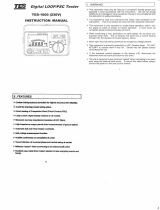
-4-
Fig. 1 Digital Loop and Ipsc Tester
2. GENERAL DESCRIPTION
The model LP2000 Digital Loop Tester is a hand-held, mains
powered instrument designed to measure the loop and prospective
short circuit current (Ipsc) of electrical circuits in accordance with
the 16th Edition of the IEE wiring regulations (BS EN 7671). It has a
3½ digit liquid crystal display and is available in various versions.
The loop is measured over two ranges to 199.9Ω with auto range at
15Ω and with resolutions of 0.01 and 0.1Ω. The Ipsc is measured
over one range of 19.99 kA with a resolution of 0.01kA.
-5-
Three measurement modes, selected by the function switch, enable
loop measurements to be made between the phase and earth
conductor in the mains lead and prospective short circuit current
measurements between the phase and neutral conductors in the mains
lead. A reading is initiated and displayed when the test button is
depressed. The lamps indicate the status of the phase neutral and
phase earth conductors and the status of those lamps can be
interpreted to determine the absence of a conductor or the reversal of
two conductors (See Wiring Fault Diagnosis Table Page 8). Fuse
protection is provided by a 5A, anti-surge fuse fitted on the printed
circuit board and a 13A fuse in the plug. Thermal overload protection
is provided by inhibiting tests for a ten second period after any test,
thus preventing over heating of the internal circuitry.
The principal of operation of the tester is that a voltage proportional
to the incoming supply on no load is compared to that same voltage
when a 10Ω load is connected for two half cycles of the mains
supply. These signals are combined and fed to a digital volt meter
LSI device whose output provides a reading of the loop resistance or
Ipsc. This device has a hold facility so that after 1 second, the
reading is retained for as long as the test button is depressed. If there
is a perturbation on the incoming supply during the measurement
cycle, the reading could be inaccurate. It is, therefore, recommended
that at least two repeatable readings are obtained.
-6-
3. OPERATING INSTRUCTIONS
3.1 SOCKET OUTLET
A. Phase Earth Loop
1) Set the function switch to P/E.
2) Connect the tester to the socket with its mains lead.
3) Check that the PE and PN lamps light. If either fails to light
then do not operate the tester, switch off the socket as there may
be a wiring fault. Correct the fault before proceeding further and
check the instrument. The Wiring Fault Diagnosis Table on page
8 may be of assistance.
4) If the READY symbol on the LCD shows, press and hold the test
button to obtain a loop reading.
5) The reading obtained in 4 should now be compared to the
appropriate table in the IEE Wiring Regulations (BS7671) to
verify the protection device against disconnection time.
B. Bonded Metalwork
1) Set the function switch to P/E2.
2) Connect the tester to a socket adjacent to the metal work with its
mains lead.
3) Plug the wander earth lead into the 4mm socket beside the mains
inlet on the tester and press the probe firmly onto the bonded
metal work. Proceed as in A, 3-5.
-7-
WARNING:
The Wiring Regulations require protective conductors (including
Bonded Metalwork) to be checked with a continuity tester before
performing a loop test. Care should be taken since when a test is
performed on a system with a poor earth, the tip of the wander earth
lead if connected will be energised for two half cycles.
C. Ipsc
1) Set the function switch to Ipsc and proceed as in A, 2-4.
2) The reading obtained will be the prospective short circuit
current (Ipsc) in kA.
3.2 THREE PHASE AND OTHER
UNTERMINATED SUPPLIES
As an accessory a multi-purpose mains lead is available which
facilitates the testing of supplies that have no socket outlet. This lead
has a moulded Euro free socket at one end and double insulated
phase, neutral and earth tails at the other. The earth tail is terminated
with a shrouded crocodile clip and the phase and neutral tails have
interchangeable fused probes and crocodile clips. If there is no
neutral available on a three phase system then the neutral probe/clip
should be taken to earth.
3.3 CIRCUITS IN CORPORATING
RESIDUAL CURRENT DEVICES
If a residual current device is incorporated in the installation, it may
be found that the RCD will trip during a phase earth loop test.This is
likely to occur where the tripping time is 20ms or less since the tester
passes up to 24A to earth during a test for up to 2 half cycles.






